
Greetings, fans of Baldur's Gate 3 and Divinity: Original Sin 2. What if I was to tell you that Larian has launched a new massive RPG that you can play right now? Sure, it may be a bit pricier than you expect, and involve more little bits of card…
Divinity: Original Sin The Board Game adapts the videogame series into a tabletop experience, complete with cards, tokens, miniatures, dice, and pretty much anything else you can imagine being scattered across a dining room table. You and your friends build your own heroes and then journey together through a branching narrative—exploring different locations, fighting monsters, levelling up, and otherwise going on a grand old fantasy adventure.
Though the story is based on Divinity: Original Sin 2, it's far from a simple retread. Beyond the changes that come with an entirely different format, it also features new characters, enemies, quests, interactions, abilities, and more, making it feel more like a reimagining or a remix of the videogame than a direct adaptation.
You may be wondering, however, why this board game is only coming out now, given Divinity: Original Sin 2 is approaching seven years old? Well… it's been a long road to get here.
The six year journey
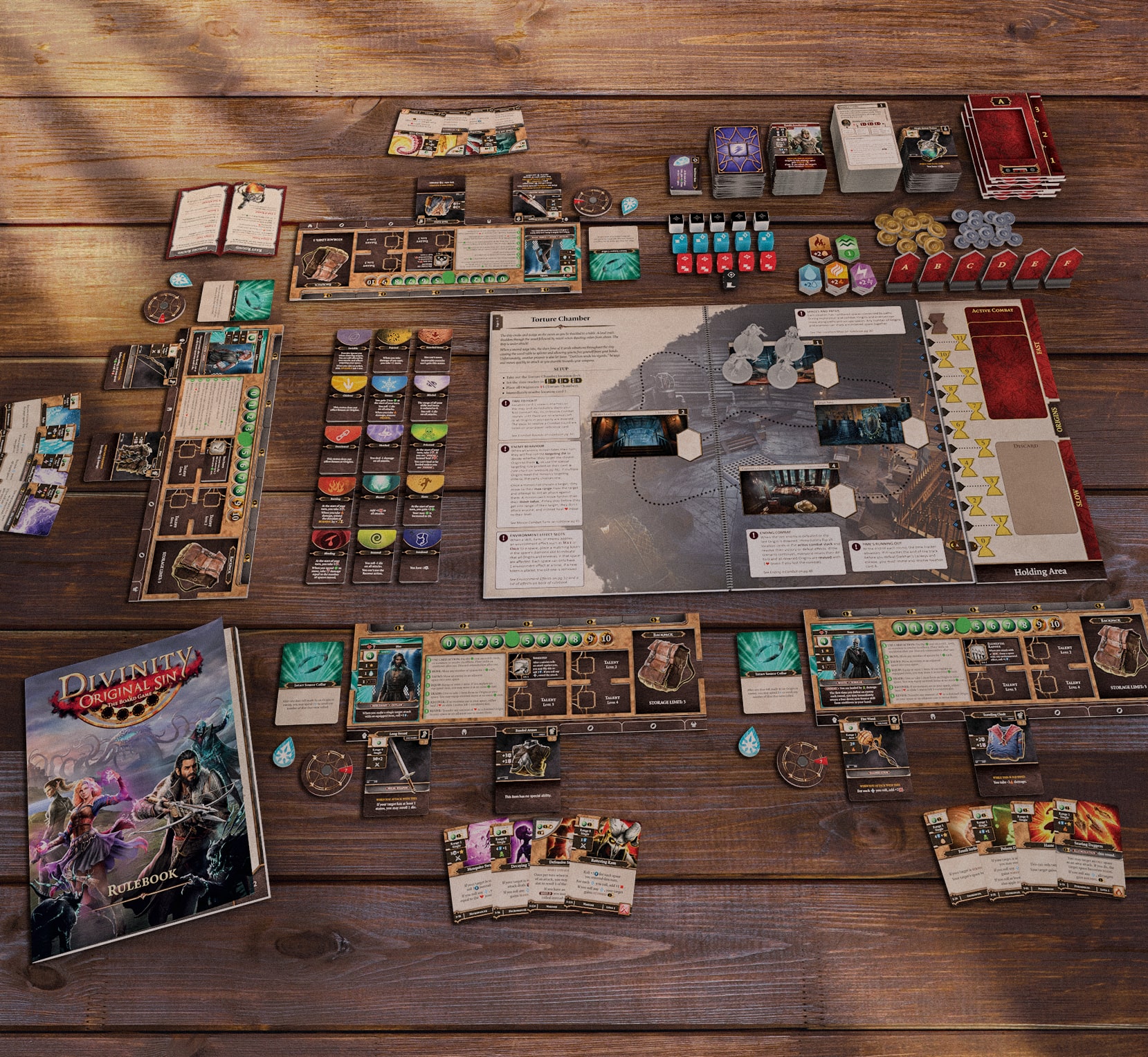
When you back a board game on Kickstarter, you expect to have a wait a while before you get it in your hands. Backers of the original campaign for this game were given an estimate of about a year before they'd receive their boxes. It ended up being closer to six.
Larian oversaw the project directly, and that protracted development certainly reflects some inexperience—perhaps even naivety—on its part when it comes to the process of making a board game. But it's also a testament to the studio's determination to get it right, no matter how long it took.
I remember the first time I got to go hands-on with the game at a preview event—I thought it was pretty cool and it seemed close to the finish line. That was five years ago. It turned out "pretty cool" was not a level Larian was comfortable settling at. The team was concerned that the elemental effects translated from the videogame were too complex in play and that the story didn't reflect the studio's focus on choice and consequence, among other issues
Since then, the game has been worked on by two different board game design teams with consultation by industry veteran Rob Daviau (Pandemic Legacy, Unmatched). Huge chunks of what I saw then have been completely rethought, even down to the board you play on—as I have my first hands-on with the latest version, I get an odd sense of déjà vu as I learn rules that have barely changed alongside ones that couldn't be more different.
For more on the game's development, the future of Divinity, and whether the developer might make more board games after this, check out my interview with Larian's Kieron Kelly.
So, the obvious question is: was it worth the wait?
Overview
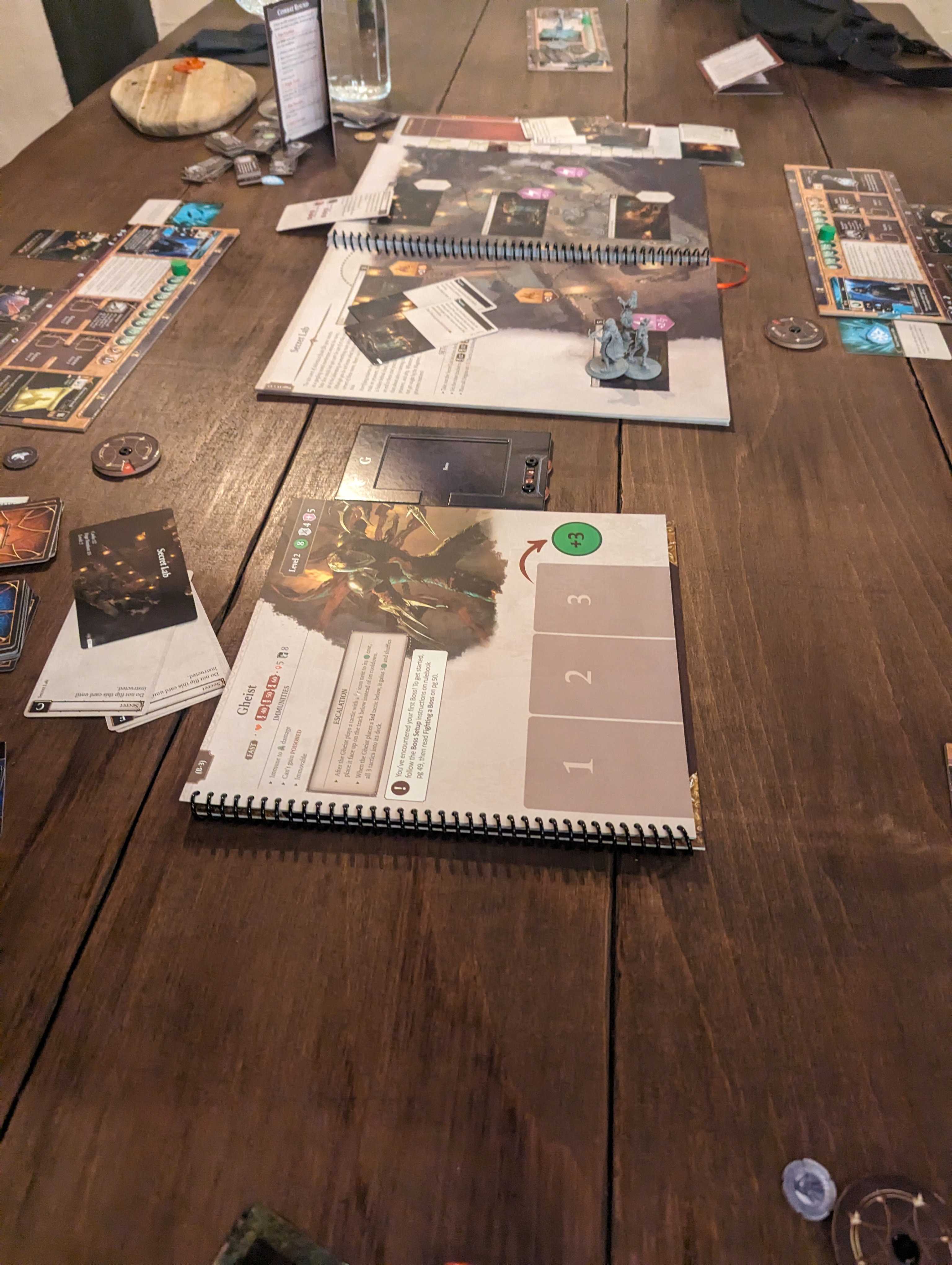
Well, I can't speak for Kickstarter backers who've been hanging around all this time waiting for a return on the $120-220 they put in. But putting its troubled history aside, I can say I think it's completely worthy of the Divinity: Original Sin name, and beyond that simply one of the coolest board games I've ever gotten my nerdy little mitts on.
The game is played across the pages of an enormous, ring bound book—the "Divine Atlas". Each two-page spread is a location, with different areas for characters to move between. As long as there are no enemies around, heroes can go where they like and each turn reveal a card from the spot they're standing at—the equivalent of exploring a room in the game. These cards play out events such as interacting with NPCs or the environment, or discovering items, and often involve choices to be made, or skill rolls to try and pass.
Inevitably, some of them involve running into enemies, at which point the rules of the game shift. You continue moving around the same location, but now you have limited action points to spend on moving and attacking. Each character has weapons and equipment they can use, and more importantly a set of skill cards. Though it makes sense to focus in on a couple of "schools" for your skills—from Geomancer (earth magic) to Scoundrel (rogue stuff) to Polymorph (shapeshifting)—you're even more free here than in the videogame to mix and match cards to create your own unique build. And it's here that things get really interesting.
Elements and combos
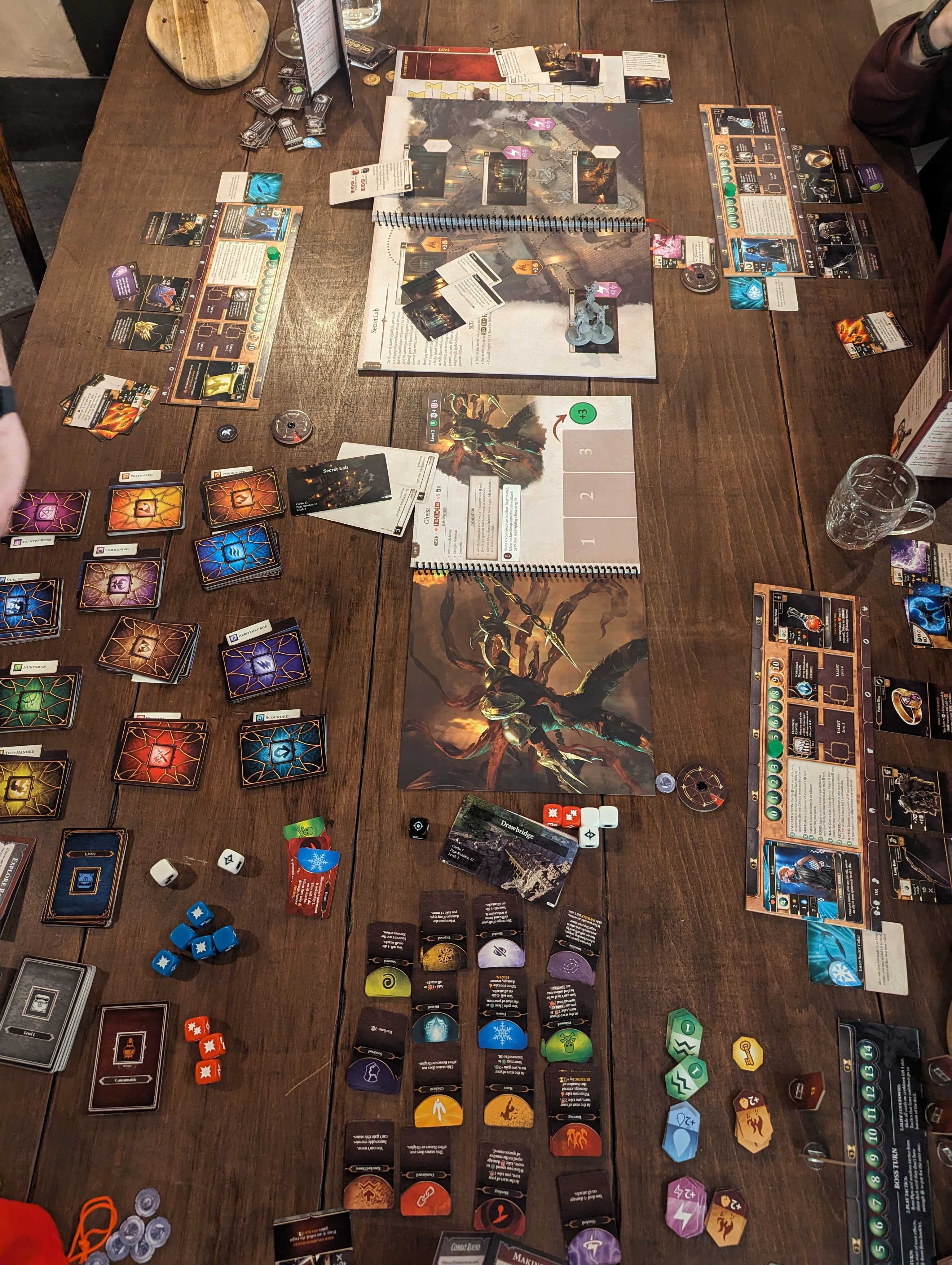
Just like in the videogame, skills can cause and inflict a huge array of different elemental effects and conditions. Characters can be bleeding, stunned, poisoned, exposed, and many more, and the areas they're standing in can become wet, warm, oily, or charged with electricity. The board game doesn't quite emulate the complex web of possible interactions between all these like the videogame does—the question of how far down that rabbit hole the design could go before becoming too alarmingly complex to play is one of the things Larian has been wrestling with all these years. Instead, it's the skills themselves that create the combos.
There's no inherent rule about what happens if you use an ice spell in a wet space, for example—instead, your Hail Strike skill will simply say "If your target is in a wet space, they become frozen". When a hero is burning, you don't track exactly how the fire is spreading, but if the Rain skill is used on them, it will note that it cures that condition—while the oily Fossil Strike skill will instead inflict extra damage.
It keeps the focus on the cards in front of you, and the cool things your character can do, rather than flipping back and forth through the rulebook. And it seems to have led the team down a wonderfully combo-rich path of combat design. Almost every card has some way of triggering a more powerful effect if it's combined with something else, with that effect often setting up another possible synergy in turn, and unlike in the videogame, that fun of stacking up interactions is just as present for everyone, rather than being primarily the domain of elemental magic.
Say I'm playing a sneaky assassin with Polymorph and Necromancy skills. On my turn, first I play Chameleon to turn invisible, then attack a foe with my dagger. The dagger has a chance to inflict poison if the dice come up right—but when I'm invisible, it lets me set a die to whatever result I want, guaranteeing the effect. Now that the enemy is poisoned, I use Decaying Touch, which ignores the armour of poisoned targets. It does a heap of damage, and also gets them bleeding—next turn, I could take advantage of that with Mosquito Swarm, which has a much higher chance to grant me a life drain effect against enemies with that condition.
And that's just one character comboing off themselves. When you've got up to four heroes all working together and setting each other up for slam dunks, it's tactical heaven—and because skills each have their own cooldowns before they can be used again, every turn you're looking at a different set of options, creating a new strategic puzzle.
Exploration and story
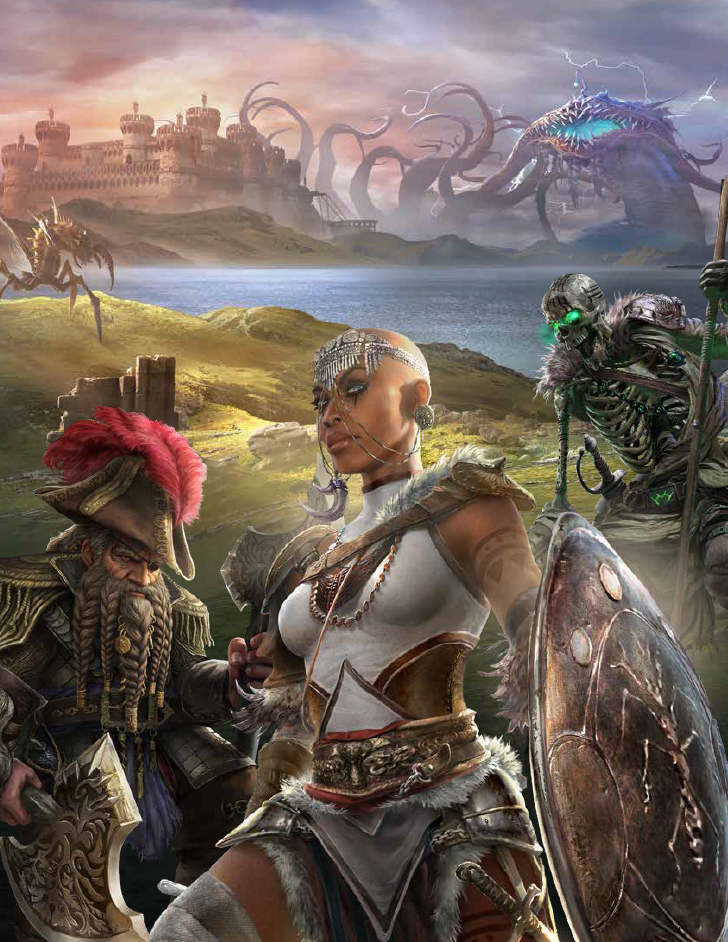
Those textured brawls are likely to take up more of your time with the game than anything else—at least based on my play experience so far (both with a full party of four, and solo controlling two characters). But I've been impressed too by the depth of the story interactions.
Again, don't expect quite the nuance of the videogame—this experience couldn't possibly replicate millions of lines of NPC dialogue and the complete freedom of exploration of Divinity: Original Sin 2. But there's a lot more story and choice here than you'd find in your average dungeon crawler board game. Location cards present different options and possible interactions: do you save a tortured prisoner, or leave him be for fear of drawing the guards' attention? Do you seek out the key to a locked door, find another way inside, or take a different path entirely? Sometimes, these decisions are recorded using cards added to an envelope that acts as your journal, allowing you to track sidequests and meet NPCs that remember your past actions.
Locations often have multiple possible exits or resolutions, in some cases sending you off to entirely different places and encounters than you would have seen otherwise. The Divine Atlas contains about 50 locations—over the course of a campaign, you might only see a quarter of them, making everyone's playthrough unique.
What's particularly fun is the ways the exploration and combat are intertwined. Choices in one mode will inevitably affect the other. Sometimes that's obvious—if you fail a stealth check on a location card and get caught, of course that'll spawn enemies for you to fight. But sometimes it's more surprising. There's one moment where, if you happened to steal a precious painting in an earlier location, you can use it in a boss fight against its owner, distracting him by throwing it off a bridge. That's if you meet him at all—depending on your choices during that act, you might end up fighting one of two other bosses, each in a totally different place.
Even your skills do double-duty—any keywords on them can be relevant to out-of-combat events. Nether Swap, for example, lets you make characters switch places in a fight, but because it has the "teleportation" keyword, it could also be used to get into a house through a high window, circumventing the need to find a conventional way in. Keywords from your origin are just as helpful—if you're a Mystic or an Outlaw, that'll help you on relevant rolls and open up options others won't have. Play as cannibal elf Sebille and you'll have Corpse-Eater, unlocking opportunities to gain the knowledge of the dead completely unique to her.
Components and verdict
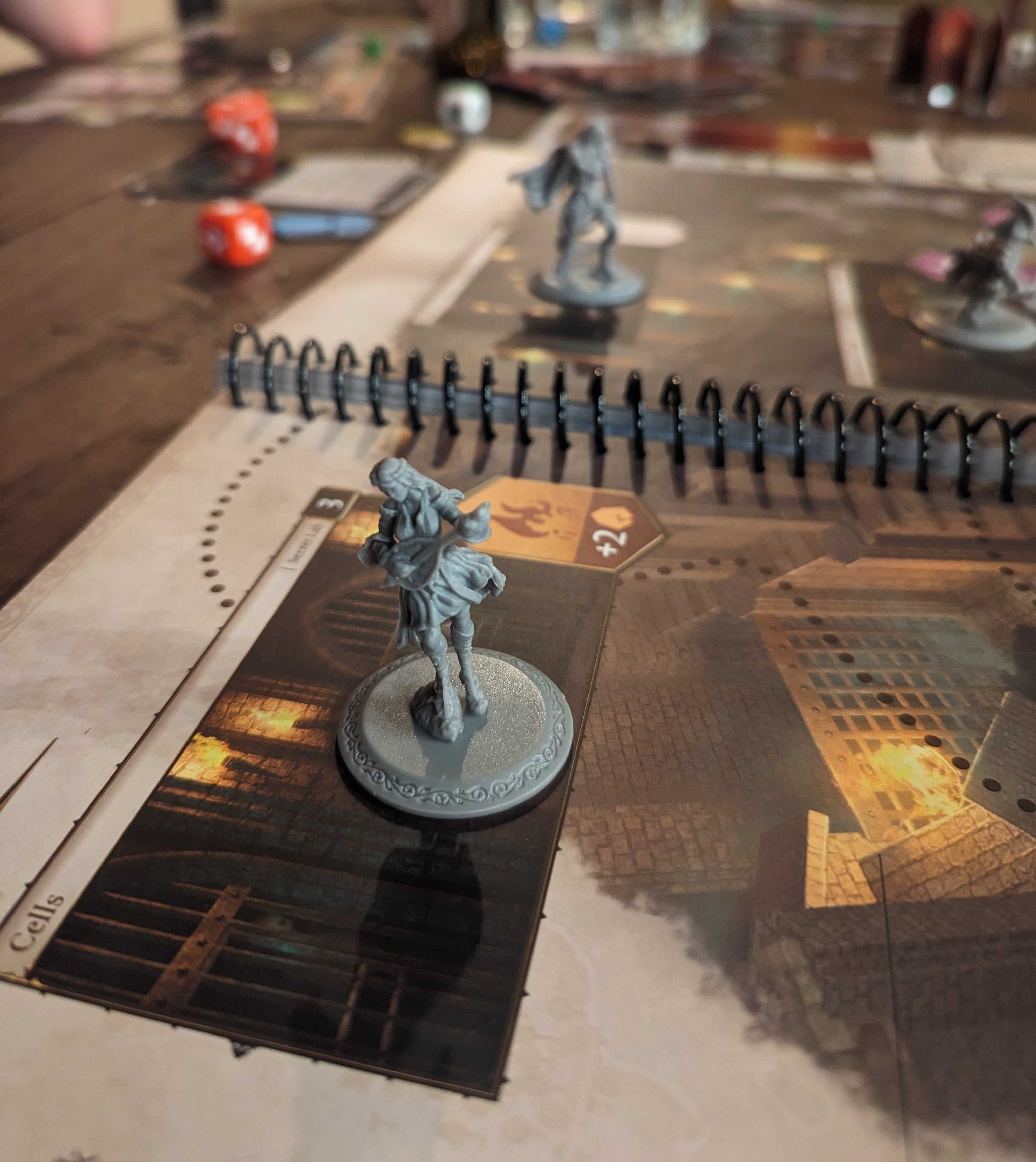
The play experience has been streamlined well over that long development period—all this depth is achieved with a surprisingly minimal amount of overhead, and the core rules are simple enough to get you playing in minutes, even if agonising over your skill cards might not go as quickly. But this is certainly a big, serious board game, with a ton of components in a massive, heavy box (or multiple boxes if you spring for the expansions). It's undoubtedly intimidating, and if you slam it on the table at family board game night, you may well be met with horrified gasps. It's one for people really ready to sink their teeth into a substantial game, and stick with it with the same group for a lengthy campaign. That won't be for everyone, especially at its significant price tag.
But if you're the kind of person who relishes the idea of sorting hundreds of cards into their trays and planning out game-winning character builds, you'll feel right at home—and I think it has the chops to stand out even from the numerous other premium, big box games available in today's Kickstarter-saturated market. Partly that's because of the distinctive design, but it's also because this game has some of the best component quality I've seen in a board game.
From the gorgeously detailed miniatures, to the sturdy card trays and trackers, to the custom dice, to the ringbound books, it's a wonderfully lavish offering. Even the box feels especially premium and sturdy, with an easy-open lid design.
Where it shines most of all is in the artwork—there's just an astonishing amount of it, orders of magnitude more than you'd normally see in a board game, and it's really fantastic throughout. Skills each have their own evocative illustrations, colour-coded for easy sorting; the countless location cards feature little scenes that evoke the look of the videogame; and the book of boss encounters dedicates a full page to showing off the majesty of each mighty monster, inspiring a little moment of genuine awe as you flip to their rules and find out how screwed you are.
All together it does feel like a real love-letter to the fans (and patient backers). Though it's a big purchase by any measure, compared to other board games at this premium end of the market, I think it's actually modestly priced for what you're getting. For all the difficulties of its development, it's a game that wouldn't have been possible without the resources of a big, successful videogame studio behind it, and you can see that advantage in the final product.
But it's not just Larian's resources that shine through in Divinity: Original Sin The Board Game. It really has that Larian spirit, translating the studio's fascination with interconnected systems, player freedom, and quirky fantasy into a whole new medium. It could be many more years yet before we get a new Larian videogame, and maybe even longer before we get another Divinity sequel—in the meantime, this is the perfect way for dedicated fans to get their fix.







